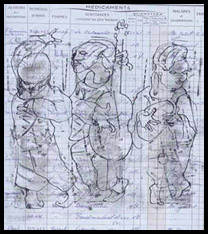 |


Her sister's was a different approach. When a child, this
girl often folded her brow at goodnight's embrace, then widened arms,
lips, and eyes in an imperious grin to command a last kiss.
"Come here," she would say, "I have something for you."
She took seemingly indifferent, sidelong notice of complex rhythms
from the piano, then sounded them in perfect time on a treble key with
one finger, just to show that nothing had escaped her. As a grown player,
she landed each beat with nonchalant precision, scraped and picked along
the rhythmic markers with such ease that the intervals between had infinite
stretch. She could roam where she would, certain of where the next accent
was to fall. For her, the music's patterns rolled on a subliminal screen
before she gave them voice with the instrument. In the wide-ranging
freedom that her sense of rhythm allowed, she had to resist merely laying
out notes in a line, inadvertently defining each beginning with prescience
of its end. When she kept her foresight in check, her perception of
the music's inner structure allowed the harmonies to vibrate, to set
up frequency multiples like colour bands in surprising identities of
emotion. Neither she nor the composer was present in the phrase, only
the disembodied intelligence and expression of the music itself: eternity
in a wisp.
There are as many manifestations of melody and dissonance as of bodies
and minds. These two musicians spun an aural twine as glossy as silk.
One fibre was sleek and fast, bright with racy highlights; the other was
strong, given to knotty, sonic bursts along the ethereal designs in the
spacing.
|
 |
 |